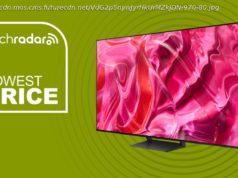We round up the biggest announcements on 5G made during MWC 2018 in Barcelona this week.
Mobile World Congress (MWC) 2018 has seen dozens of 5G-related announcements, spanning devices, modems, radios, plans, spectrum, and trials.
We round up the biggest announcements on 5G made during MWC in Barcelona this week, and the information we gained from carriers, vendors, and networking companies.
Intel is already working with Dell, HP, Lenovo, and Microsoft on bringing 5G connectivity to Windows PCs using the Intel XMM 8000-series commercial 5G modems.
It is showcasing its first 5G-enabled 2-in-1 concept PC during MWC, which is powered by its 8th-generation Core i5 processors and an early 5G modem, with the expectation of bringing 5G-connected PCs to market in the second half of 2019.
Intel also announced a “multi-year collaboration” with Spreadtrum to produce a 5G phone platform by the second half of 2019 using Intel’s XMM 8000-series modem alongside Spreadtrum’s application processor.
“We’re excited about this development, because this is a great opportunity to bring the XMM 8000 series not only as I mentioned earlier as a PC form factor, as well now into mobile and smartphone handset form factors,” Intel GM of 5G Advanced Technologies Rob Topol told media.
“In our booth as well, we will have a chipset base first 5G-enabled 2-in-1 concept.”
Huawei launched its first commercial 5G CPE, a terminal device supporting 3GPP 5G standards with a Huawei-developed Balong 5G01 chipset, as part of its end-to-end 5G solution.
According to the Chinese networking giant, this is the world’s first commercial 3GPP 5G chipset supporting download speeds of up to 2.3Gbps across sub-6GHz and millimetre-wave (mmWave) spectrum bands.
“The Balong 5G01 makes Huawei the first company offering an end-to-end 5G solution through its network, devices, and chipset-level capabilities,” Huawei said, with the CPE coming in a sub-6GHz model and an mmWave model, as well as indoor and outdoor units.
“The Huawei low-frequency 5G CPE is small and lightweight, compatible with 4G and 5G networks, and has proven measured download speeds of up to 2Gbps — 20 times that of 100Mbps fibre. This provides an ultra-fast experience, allowing users to enjoy VR video and gaming experiences, or download a TV show within a second.”
Claiming to be the only company to launch full 5G end-to-end solution, Huawei also pointed towards its entire 5G portfolio for 2018: Massive MIMO macro, including the AAU5612, the AAU5310i, and the HAAU5213; Massive MIMO pole site, including the HAAU5112 and the EasyBlink; small cell, consisting of its 5G Lampsite product; devices, including the 5G CPE; baseband, including the BBU5900 and CBU5900; transport, including microwave, IPRAN, FO OTN, and WDM products; and core, consisting of its cloud-based product.
Like Huawei, ZTE’s 5G CPE is already under development, with the fellow Chinese company saying it will launch 5G smartphones and tablets in either late 2018 or early 2019.
ZTE further stated that it will be deploying networking products across commercial 5G networks by the first half of next year, with the Chinese telecommunications technology provider also saying it is “well prepared to help operators deploy 5G”.
“Ready for commercialisation, ZTE’s 5G solutions are going to be launched soon,” the company said. “As a pioneer in the 5G era, ZTE has made the rollout of its 5G solutions the core goal.”
Alongside the company’s 1.2Gbps-capable smartphone announcement this week, ZTE explained that it is helping partners with technology verification through what it called “the most commercially viable 5G field test network currently available”.
Australian carrier Telstra finally announced its 5G launch plans, aiming to provide 5G to major cities and regional areas by the end of 2019 using both sub-6GHz and mmWave spectrum.
According to Telstra’s 5G roadmap, 2018 will see the deployment of over 1,000 small cells in metro areas to increase capacity, and 4G and 5G integration trials with Ericsson, Intel, and Qualcomm, including interoperability testing.
“Our objective will be to lead the development in 5G, and be the leader in the rollout of Australia, but it’s not just about being first — it’s about making sure you have a fully integrated and extensive 5G set of offerings,” Telstra CEO Andy Penn told ZDNet at MWC.
“We’ve always been a leader in technology and will continue to be so, and as I said it’s one thing to just sort of put a flag in the ground, but what’s more important is we have an integrated set of 5G solutions for customers, and also we will continue to invest in and develop the capability of 4G as well.
“Because ultimately, whilst 5G might be available commercially in 2019, realistically not everybody is going to suddenly switch to 5G; there will still be many customers on 4G.”
Sprint used MWC to announce that it will be bringing 5G networks to Los Angeles, Washington DC, Atlanta, Chicago, Dallas, and Houston first, with the six cities to begin experiencing “5G-like capabilities” as of April.
The upgrades will begin with the rollout of Massive MIMO in LA, Chicago, and Dallas, with an “aggressive” expansion into additional markets later in the year.
As part of this, Sprint will deploy thousands of Massive MIMO radios from Ericsson, Nokia, and Samsung, as well as 40,000 outdoor small cell solutions, 15,000 stand-mounted small cells, and 1 million Sprint Magic Boxes — labelled the world’s first wireless small cells — to cell towers.
“The race to 5G is heating up, and let me be clear: Today’s announcement is a huge step toward Sprint being first to offer a 5G mobile network,” Sprint CEO Marcelo Claure said.
“Our deep spectrum position gives us an incredible advantage no other carrier has in the US. We’re making significant investments using state-of-the-art technology, and working with leading chip and handset partners to deliver an incredible next-gen network for our customers.”
Ericsson CEO Börje Ekholm announced the Swedish networking giant’s guide for how telecommunications carriers can maximise revenues during the transition to 5G, predicting that real-time automation has a revenue potential of $101 billion by 2026.
Enhanced video services came in second, with potential revenue of $96 billion, according to Ericsson, although Ekholm believes enhanced mobile broadband will be the first commercial deployment of 5G.
On net neutrality, Ekholm said that while Ericsson believes in non-discriminatory access to information and data, he added that “not all traffic is created equal” — and that once critical applications such as remote surgery are being performed over 5G, they should be given priority over other traffic.
The Ericsson CEO also said governments should help enable 5G by making new spectrum available and providing a “stable regulatory environment” and faster permitting processes.
Intel announced that it will partner with Japanese telecommunications carrier NTT DoCoMo on providing 5G coverage and technology for the 2020 Olympic Games in Tokyo.
Some of the applications that can be expected at Tokyo 2020 according to Intel include 360-degree 8K video streams with real-time broadcasts, including VR applications; drones kitted out with HD cameras; smart city sensors and connected cars, which will enable better transport options throughout Tokyo; and access to data and analytics during Olympic training for athletes.
“As we look to 2020, Intel is excited to unveil today our collaboration with NTT DoCoMo, a National Partner of Tokyo 2020, to provide 5G technology for the next Olympic Games. Intel hopes to establish what’s expected to be the world’s largest 5G commercial network,” Intel SVP and chief strategy officer Aicha Evans said.






